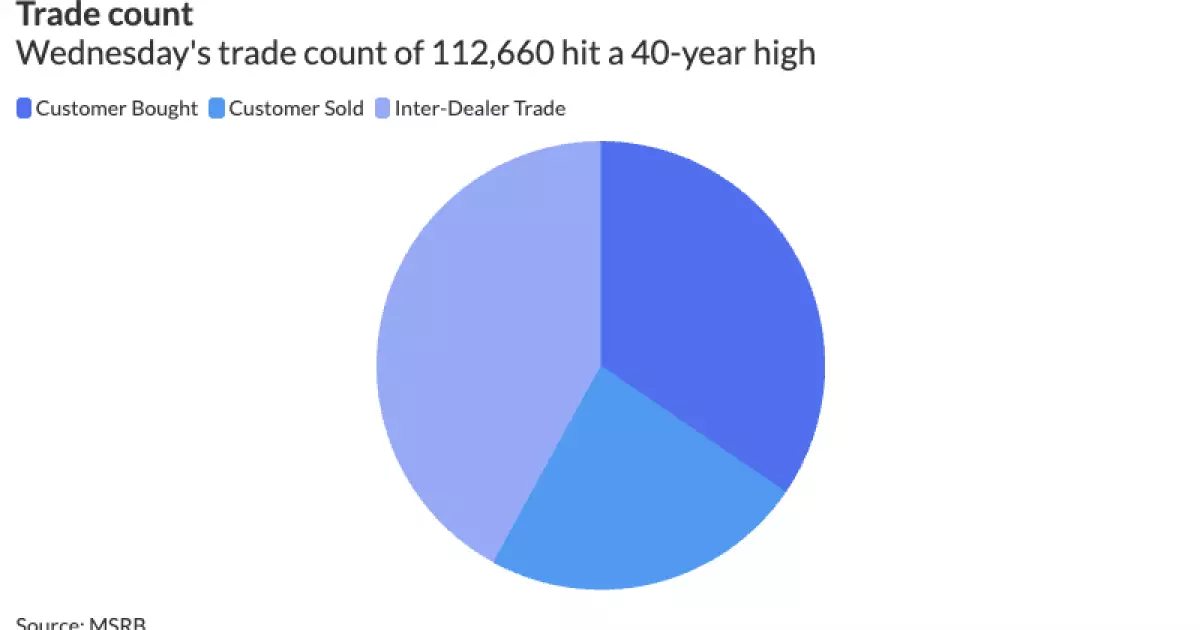The municipal bond market is no stranger to volatility, yet the recent developments can only be described as a roller-coaster of unpredictable shifts. On Thursday, as yields for AAA-rated bonds tumbled dramatically, the markets witnessed both an emotional release and a sense of systemic frailty. Analysts reported that yields had plummeted by 30 to 50 basis points, damping a disastrous Tuesday where negative returns stung like a hornet’s nest. What’s astonishing is the rapid shift from vulnerability to hope, triggered predominantly by the announcement of a 90-day pause on President Donald Trump’s stringent tariff policies. Considering these tumultuous dynamics, one cannot help but wonder about the foundations of investor confidence.
It’s notable that March 2020—a period marked by rampant uncertainty due to the pandemic—still cast a long shadow over the yield movements we see today. Financial experts have described the sequence of events as some of the most turbulent on record, but the question lingers: Is this volatility simply an ephemeral expression of market anxiety or a symptom of a deeper, systemic ailment? Investors are left grappling with emotional distress, markedly exemplified by comments from BlackRock’s Chief Investment Officer, Sean Carney, who articulated that on certain days, selling bonds felt like an exercise in futility. The persistence of such scenarios suggests that a confluence of market sentiments and fundamental weaknesses could culminate in a crisis.
Market Liquidity Under Siege
In a market environment rife with uncertainty, liquidity acts as the lifeblood that sustains investor confidence. However, recent data paints a bleak picture of liquidity in the municipal sector. A staggering number of transactions—112,600—took place on Wednesday alone, marking the highest volume since 1995, yet this only underscores the deepening crisis. With over $32.5 billion exchanged, the sheer volume feels like frantic paddling against an unrelenting tide. The average trade volume of about 11,964 trades and $11.9 billion per day suddenly seems like an idealistic remnant of a happier time.
These chaotic trading dynamics underline a hyper-sensitive environment that cries out for stability. Despite a temporary reduction in bid-wanted activity following the tariff news, the sheer volume of sellers found scrambling for AAA-rated bonds suggests that deeper cracks are forming in market liquidity. Jeff Timlin from Sage Advisory offered a somewhat optimistic view, stating that, despite broad-based selling, there has been a notable lean towards more stable AAA bonds. But how long can this fragile balance be sustained when selling pressures remain intense?
The Threat of Overreaction
One crucial aspect of financial markets is how investor psychology can warp the reality on the ground. The response to Trump’s tariff deferral may very well illustrate this phenomenon. While the announcement motivated a swift rebound in bond prices, it also triggered a mix of expectations and fears. Carney’s insights about the impending day-to-day reset reflect a desperate desire for clarity amidst uncertainty. Potential investors might find themselves oscillating between buy and sell decisions based on fleeting news cycles, creating an unpredictable climate that could further exacerbate market performance.
The acute threat here lies in overreaction. As one sector struggles for breath, another may see inflated gains that lack substantial backing. If market behavior is swayed more by the whims of political announcements than by tangible economic indicators, then the entire atmosphere becomes charged with volatility that investors cannot afford to ignore.
Long-term Consequences: A Dimming Outlook
Although some traders may breathe a sigh of relief following a short-term fluctuation, it is the long-term landscape that garners concern. Industry strategists from J.P. Morgan highlight that the past week illustrates the complex interplay between market-driven events and economic fundamentals. With supply pressures continuing amid postponed deals, we cannot dismiss the likelihood that municipal bonds can only see limited recoveries in the near future. As redemptions and coupon payments begin to surface, one can only speculate if they will provide a lifeforce to an otherwise dwindling environment.
The reality remains that the shaky foundations of the municipal bond market are far from resolved. Those who choose to plunge back in may do so at their peril, with a market that seems to shuffle between hope and despair. The question remains: How might these unpredictable oscillations alter investor strategies and risk appetites moving forward? In the throes of this financial tempest, only time will tell whether the municipal bond market can reclaim its footing or if it’s destined for further upheaval.

